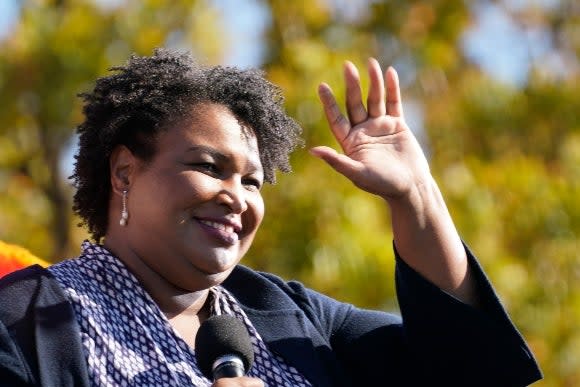Black women leaders are determined to be among the ranks of governors
- Oops!Something went wrong.Please try again later.

In the seven years that Higher Heights and the Center of American Women and Politics have been issuing the Black Women in American Politics status updates, the data has consistently highlighted a challenging reality: Although more Black women are running and winning each year, only a handful have hurdled the very significant, long-standing racial and gender barriers to holding elected statewide executive offices. While Black women make up nearly 7 percent of the U.S. population, we account for less than 2 percent of elected officials in this category, and not one Black woman has ever served as governor in the country's 245-year history.
The historical absence of Black women on the gubernatorial level is a problematic representational void for the nearly 23 million Black women and girls in the U.S., and the almost exclusively white, overwhelmingly male gubernatorial leadership is detrimental to the country as a whole.
State-specific policies and laws that governors sign into being often impacted people's lives more significantly than anything created on the national level. What's more, governors wield a great deal of power over how national policies get implemented and the strength with which some federal laws are enforced in their states. The lack of diversity among governors' offices means important perspectives, lived experiences and critical knowledge often don't make their way into the mix that informs these kinds of decisions.
The lack of gender and racial diversity on the gubernatorial level also means a dearth of diversity in the National Governors Association. Currently, 41 of the association's members are white men, and four of the five members of color--only one of whom is a woman-represent U.S. territories, not official states. The association was designed to share policy- and lawmaking successes across states and pressure Congress and the White House to reach bipartisan agreements that work for and represent the concerns of all Americans. But it's pretty impossible for an organization to achieve these public interest goals when its membership is devoid of any impactful level of inclusive perspectives and in particular when Black women-a group that represents a sizable percentage of the U.S. population and that has the highest rate of workforce participation of all women in the U.S. -are completely locked out of gubernatorial representation.
Any of these reasons is a compelling argument for the critical importance of diversifying gubernatorial leadership, but there are particularly compelling reasons for supporting Black women candidates in their efforts to breakthrough this detrimental gender and racial barrier, not the least of which are the clear qualifications of the ones who recently have and currently are making their bids for governors' offices.
Stacey Abrams' success in becoming the first Black woman to win a major party nomination for governor and her highly competitive run against the now-incumbent governor, Brian Kemp, in 2018 was the result of years of successful policymaking, relationship building and beneficial representation on behalf of her constituents while she was in the state legislature. More recently, a diverse field of four Black women made their bids for governor of Virginia during the 2021 state primary. Two of the candidates-Jennifer Carroll Foy and Jennifer McClellan, who both have served in the Virginia legislature-came in second and third respectively in the five-candidate Democratic field. They also were among the top fundraisers and endorsement receivers, narrowing the gap on areas of support that have traditionally been withheld from Black women candidates, who despite their qualifications often have been labeled "unelectable."
Some largely homogeneous state legislatures are using voter suppression laws to reinforce barriers to Black women's political leadership gains, but the achievements of former Black women gubernatorial candidates, as well as those who have been successful in serving as lieutenant governor, are making deep cracks that will inevitably shatter the glass ceiling. The forthcoming midterm elections could be the watershed moment for this long-overdue broadening of America's leadership at the highest levels.
At least six Black women have announced their 2022 gubernatorial runs. The highly qualified candidates include Abrams, who just recently announced her plans to again challenge Kemp for leadership of Georgia. Other candidates include New York's Letitia "Tish" James, who is currently the state's attorney general; Iowa's Deidre DeJear, whose business has helped more than 600 small businesses across her state and assisted 120 in surviving the pandemic; South Carolina's Mia McLeod, who is a state senator; and Massachusetts' Danielle Allen, a nonprofit leader and policy innovator. Each of these women brings diverse experiences and deep knowledge of underrepresented communities that could help positively transform the states they are vying to lead.
It's broadly expected that more Black women--including, possibly, Stacey Abrams--will enter races for governorships across the country over the next few months. To paraphrase Democratic strategist Seve Schale, Black women have shown they can assemble the ideal big-tent alliances needed to win elections in our fastly diversifying country. They are also capable of providing leadership that is responsive to the broad swath of Americans' needs - not just the rich and powerful. Now it's up to voters to decide if we really want a country that delivers on its promises or one that just rests on meaningless words.
Glynda Carr is president and CEO of Higher Heights for America, the only national organization providing Black women with a political home exclusively dedicated to harnessing their power to expand Black women's elected representation and voting participation, and advance progressive policies.
